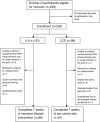Arterial stiffness, lifestyle intervention and a low-calorie diet in morbidly obese patients-a nonrandomized clinical trial
- PMID: 23712971
- PMCID: PMC3770926
- DOI: 10.1002/oby.20099
Arterial stiffness, lifestyle intervention and a low-calorie diet in morbidly obese patients-a nonrandomized clinical trial
Abstract
Objective: Arterial stiffness is an independent predictor of cardiovascular morbidity and mortality. This study aimed to compare the 7-week effect of a low-calorie diet (LCD) and an intensive lifestyle intervention program (ILI) on arterial stiffness in morbidly obese individuals.
Design and methods: Nonrandomized clinical trial. The LCD provided 900 kcal/day, and participants in the LCD group were instructed to maintain their habitual physical activity level. The ILI included two 90-min supervised training sessions 3 days a week at moderate to high intensity (4-8 METs) and a caloric restriction of 1000 kcal/day.
Results: A total of 179 individuals completed the study, 88 (56 women) in the ILI group and 91 (57 women) in the LCD group. High-fidelity applanation tonometry (Millar(®) , Sphygmocor(®) ) was used to measure carotid-femoral pulse wave velocity (PWV). After adjustment for relevant confounders, the ILI group had a significantly greater reduction in PWV than the LCD group; -0.4 (-0.6, -0.1) m/s, P = 0.004. When compared to the LCD group, the ILI group showed a larger reduction in systolic and diastolic blood pressure -5 (-9, -1) and -5 (-7, -2) mmHg, P = 0.038 and P ≤ 0.001 respectively, whereas no difference was observed regarding pulse pressure, P = 0.661. No significant differences between groups were found regarding the loss of fat mass, P = 0.259, but the loss of muscle mass was larger in the LCD group, 0.8 (0.5, 1.1) kg, P ≤ 0.001.
Conclusion: Despite the limitations of a nonrandomized design, our findings indicate that for morbidly obese individuals a moderate caloric restriction combined with aerobic physical exercise is associated with a greater decline in PWV than a LCD alone.
Copyright © 2013 The Obesity Society.
Figures




References
-
- Melanson KJ, McInnis KJ, Rippe JM, Blackburn G, Wilson PF. Obesity and cardiovascular disease risk: research update. [Review] [50 refs] Cardiol Rev. 2001;9:202–207. - PubMed
-
- Flegal KM, Carroll MD, Kit BK, Ogden CL. Prevalence of obesity and trends in the distribution of body mass index among US adults, 1999–2010. JAMA. 2012;307:491–497. - PubMed
-
- Freedman DS, Khan LK, Serdula MK, Galuska DA, Dietz WH. Trends and correlates of class 3 obesity in the United States from 1990 through 2000. JAMA. 2002;288:1758–1761. - PubMed
Publication types
MeSH terms
Substances
LinkOut - more resources
Full Text Sources
Other Literature Sources
Medical

